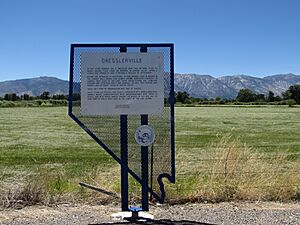Washoe Tribe of Nevada and California facts for kids
| Total population | |
|---|---|
| 1116 (1990s) | |
| Regions with significant populations | |
| Languages | |
| English, Washo | |
| Religion | |
| traditional tribal religion, Native American Church, previously Ghost Dance | |
| Related ethnic groups | |
| Northern Paiute, Miwok, Maidu, and Nisenan |
The Washoe Tribe of Nevada and California is a group of Washoe Indians. They are a federally recognized tribe, which means the United States government officially recognizes them as a sovereign nation. They live in parts of California and Nevada.
The Washoe people have several communities located south and east of Lake Tahoe. These communities work together under a tribal council. The Washoe people also own over 64,300 acres (26,000 ha) of land called public domain allotments (PDAs). These are special areas of land set aside for Native American individuals or families. Even though the tribal government doesn't directly control these lands, they are still an important part of the Washoe people's territory.
Contents
Washoe Communities: Where They Live
The Washoe Tribe lives in several important communities. Each community has its own history and special features.
Carson Colony: A Community in the City
The Carson Colony was started in 1917. This community is about 16-acre (6.5 ha) in size and is located in Carson City, Nevada. In 1991, about 275 people lived there. The colony has a gymnasium that is used for sports, youth programs, and tribal events. Four community representatives help lead the Carson Colony.
Dresslerville Colony: The Largest Washoe Home
The Dresslerville Colony is the biggest Washoe community by population. In 1991, 348 members lived there. It covers about 90 acres (36 ha) near Gardnerville Ranchos. Many of the tribe's main buildings are here, including a community center, a gymnasium, and a park. This community has five representatives.
Stewart Community: A Historic Place
The Stewart Community is located on the south side of Carson City. It was established a long time ago, in 1890. This community has 2,960 acres (1,200 ha) of land and was home to 90 members in 1991. They have their own Stewart Community Center. Five community representatives help guide this community, and Wanda Batchelor is their chairperson.
Washoe Ranch: A Farming History
The Washoe Tribe bought this 95-acre (38 ha) ranch in Carson Valley in 1938 and 1940. For a while, the tribe worked together to raise animals like hogs, sheep, and dairy cows. They also grew crops such as potatoes and peaches. In the 1950s, when farming became less common, the land was temporarily rented to non-Native farmers.
Woodfords Community: The California Home
The Woodfords Community is the only Washoe community located in California, near Markleeville. Its Washoe name is "Hung A Lel Ti." This community has the Woodfords Indian Education Center and a community center. Five community representatives lead this area, with DeAnn Roberts as their chairperson.
The Woodfords Community was established in 1970. In 1991, it had 338 residents. By the 2010 Census, the population was 214. In July 2021, the community had to be evacuated for seven days because of the Tamarack Fire. Luckily, the community was successfully protected from the fire.
Washoe History: Challenges and Progress
The Washoe people have a long and rich history, but they also faced many challenges, especially after European-American settlers arrived.
Impact of the Gold Rush
In the mid-1800s, the California Gold Rush brought many new settlers to the Washoe lands. This led to a loss of resources for the Washoe people, including their important piñon crop. The Washoe asked the U.S. government for a reservation and payment for their lost resources, but these requests were ignored in the late 1800s.
Land Changes and New Colonies
Under a law called the Dawes Act of 1887, Washoe lands were divided into individual plots. However, instead of getting good land, the Washoe often received dry, barren areas with little water.
In the early 1900s, many Washoe people worked on ranches, in construction, or as domestic helpers. Ranchers would rent Washoe land for very little money. In 1917, the U.S. government bought land for the Washoe, which became the Carson Colony. Also in 1917, William F. Dressler donated 40 acres (16 ha) of land, which became the Dresslerville Colony.
Gaining Federal Recognition
Under the Indian Reorganization Act, the Washoe communities in the Carson Valley area created a new constitution and rules. They approved these on December 16, 1935. This led to them gaining official federal recognition on January 24, 1936. This recognition meant the U.S. government officially recognized the Washoe Tribe as a sovereign nation.
Seeking Justice for Land
In 1948, the Washoe Tribe began preparing a case for the Indian Claims Commission. They filed their case in 1951, asking for $43.8 million. This money was for land, fishing and hunting rights, minerals, and timber that had been unfairly taken from the tribe, plus interest since 1863. The case was finally settled in 1970, but the tribe was only awarded $5 million.
Working Together: The Inter-Tribal Council
In the 1960s, a man named John Henry Dressler helped create the Inter-Tribal Council of Nevada. This council helps connect tribal groups with state and federal agencies. Since 1966, the council has nine representatives: two from Dresslerville Colony, two from Woodfords Colony, one from the Washoe of Reno-Sparks Indian Colony, and two from areas not on reservations.
Images for kids








